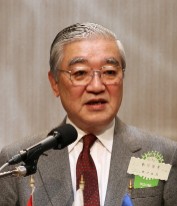��Learning in the Edo Period and Environmental Issues��
February 6, 2008
Mr. Tsunenari Tokugawa,
President of Tokugawa Memorial Foundation,
Senior Advisor of Nippon Yusen Kabushiki Kaisha
��
 ��In the 17th to 18th Century, the population of Japan at the beginning of the Edo Period was roughly 12 million. In the Genroku Period, the population grew to 30 million. The population had increased two and a half fold in just the 100 years of the 17th Century.
��In the 17th to 18th Century, the population of Japan at the beginning of the Edo Period was roughly 12 million. In the Genroku Period, the population grew to 30 million. The population had increased two and a half fold in just the 100 years of the 17th Century.
��Another notable noble fact about the period was the high level of education that had been spreading. The education system at that time can be classified roughly into three segments.
��The first segment, the children of the samurai, who comprised 5-7% of the population, studied Confucianism at feudal clan schools or schools run by Confucian scholars. The content of this type of education was more geared toward formation of human character than the acquisition of knowledge. The disdain of the acts of talking with girls and conversing about money was also taught at these schools.
��Children of common townspeople went to temple schools. There were no grades and classes, but the teacher gave each child an education that was appropriate for that particular child. For children from merchant houses, they taught commercial comings and goings, while for children of carpenters, they taught carpentry, plastering and the like. They taught the children how to read and the writing of vocabulary that was used in the occupation of each household. If there was a lag in the pace of learning, it was not a cause for concern, and the only subject that was taught as a group was calligraphy.
��12 or 13 year old boys who had completed temple school went on to apprenticeships or became disciples and boarded at someone��s house. The children would spend 9 to 10 years apprenticing or leaning at the house. When they went out into the society, they were 21 to 22 years old, and by that time they would be fully grown men. This was the general educational system. In farming households, after receiving education at the temple schools, the children joined a group called the ��Young Men��s Band�� or ��Wakashugumi��, .the members of which worked on local irrigation construction and village events.
��In any case, after the age of 12 or 13 they received training in society and when they reached age 20, they were considered adults. All of this is what is considered to be the traditional Japanese educational system.
��Reading from a block print of ��Nihombashi�� which was drawn around the year 1800, the ships rushing to the shore were all ��eight-oared boats��. They were said to be so quick that it looked as if they were flying, and the print depicts the ships quickly unloading fish freshly caught in the Edo Bay. In an age when there was no freezing or refrigeration, in order to keep the fish fresh, speed was of the essence.
��In the print, many people were depicted engaged in trade carrying poles on their shoulders, and it is said that 70% of them were sellers and only 30% were buyers. Sellers handled daily necessities such as fish, vegetables, and other foodstuffs. Whereas buyers bought any and all things including used clothes, used paper, sandals, torn umbrellas, ash from furnaces, hair that had fallen on the floor of a hairdresser��s shop, and the little candle ends leftover in candle stands. At that time anything that was no longer of use could be sold, and almost everything was recycled and reused in this manner.
��An excellent example of a recycled item from the Edo Period was human excrement. Excrement that was collected was given to farmers which, after further fermentation in a manure pool, became fertilizer. Vegetables were grown using this fertilizer, which was eaten by people, thus completing the cycle. Wood waste from making wooden sandals was used as fuel for bath houses. Truly everything was recycled and reused.
��There was almost no garbage generated from the city of Edo, now known more commonly as modern day Tokyo. Other regions outside Edo also practiced similar recycling and reusing methods. In the island country of Japan, a culture of life had developed that recognized the balance between domestic population and nature.
��Today, Japan��s food self-sufficiency ratio is below 40%. I take issue with the idea that so long as there is money there are no worries about the supply of food. Recently, as the chairman of the World Wide Fund of Nature Japan (WWF), after listening to the thoughts of representatives of various countries in international conventions, have had some thoughts cross my mind about the environment. Japanese environmental measures lag far behind other advanced nations. In the United States, at the state level remarkable progress has been made in energy conservation measures. England, Germany and the Netherlands have all stated that they intend to fulfill their commitments under the Kyoto Accord.
��The environmental issue has become a passionate one, so much so that it has almost become a new world religion. In Europe, 80% of people believe that it is their duty to create a suitable earth for their children. Japan has been content with emotional ecology measures. I fear that if things continue as they are, Japan may once again be left behind in the world as an orphaned child.